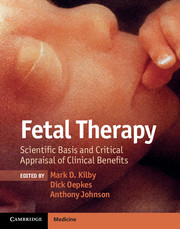Book contents
- Frontmatter
- Contents
- Contributors
- Foreword
- Preface
- Section 1 General principles
- Chapter1 The rationale for fetal therapy
- Chapter 2 Insights into pathogenesis of adult cardiovascular disease from fetal animal studies
- Chapter 3 Human embryology
- Chapter 4 Ethics of fetal therapy
- Chapter 5 Fetal therapy choices
- Section 2 Fetal disease
- Glossary
- Index
- References
Chapter 2 - Insights into pathogenesis of adult cardiovascular disease from fetal animal studies
from Section 1 - General principles
Published online by Cambridge University Press: 05 February 2013
- Frontmatter
- Contents
- Contributors
- Foreword
- Preface
- Section 1 General principles
- Chapter1 The rationale for fetal therapy
- Chapter 2 Insights into pathogenesis of adult cardiovascular disease from fetal animal studies
- Chapter 3 Human embryology
- Chapter 4 Ethics of fetal therapy
- Chapter 5 Fetal therapy choices
- Section 2 Fetal disease
- Glossary
- Index
- References
Summary
Introduction
A number of potentially serious clinical conditions originate during fetal life, and these include neurological handicap, premature birth, intrauterine growth restriction, and pulmonary hypoplasia. These are often viewed as “pathophysiological” conditions where normal development (or physiology) has been disrupted by a challenge in utero which has immediate and longer-term damaging effects. Coexisting with these substantial obstetrical concerns is the current worldwide epidemic of non-communicable disease including cardiovascular disease (CVD), type 2 diabetes, chronic lung disease, and some forms of cancer. Predisposition to these is also linked to obesity. Epidemiological observations over the last 30 years have further implicated the early environment (from preconception to childhood) in an increased risk of these non-communicable diseases in adult life. Current concepts suggest that the developing organism may respond to cues (e.g., nutrient supply, maternal stress) from the environment and that its development is “channelled” (rather than disrupted) to give a phenotype optimized for the subsequent postnatal environment. However, there may be limits to the responses that the developing organism (e.g., fetus) can make, or the postnatal environment may not turn out to be what was expected. Either or both of these circumstances may lead to an increased disease risk in adulthood.
Keywords
- Type
- Chapter
- Information
- Fetal TherapyScientific Basis and Critical Appraisal of Clinical Benefits, pp. 12 - 23Publisher: Cambridge University PressPrint publication year: 2012

